Less is More: Decluttering the Eco-Friendly Way

Ever felt overwhelmed by the stuff in your home? You’re not alone. In today’s world, we often think more is better. But what if less could actually give us more? Welcome to the world of eco-friendly decluttering, where less really is more.
Imagine a home where you can breathe easier, think clearer, and feel happier. That’s what decluttering can do for you. But it’s not just about tidying up. It’s about making choices that are good for you and the planet.
In this post, we’ll explore how to declutter in a way that’s kind to the Earth. We’ll show you how sustainable minimalism can transform your space and your life. Ready to start your green home organization journey? Let’s dive in!
Benefits of Decluttering
Mental Health Benefits
Clearing out clutter isn’t just about making your home look nice. It can actually boost your mental wellbeing. Here’s how:
- Less stress: A tidy space means a calmer mind.
- Better focus: With fewer distractions, you can concentrate better.
- More creativity: A clear space can lead to clearer thinking.
When you’re not constantly looking for things or feeling stressed about mess, your mind is free to focus on what really matters.
Environmental Benefits
But the benefits don’t stop with you. Decluttering the eco-friendly way is also a win for our planet:
- Reduced consumption: When you buy less, you use fewer resources.
- Lower carbon footprint: Fewer things mean less energy used in production and transport.
- Support for sustainable living: By choosing quality over quantity, you encourage better manufacturing practices.
Every item you decide not to buy or keep is a small victory for the environment. It’s a powerful way to show that you care about the world around you.
Eco-Friendly Decluttering: Getting Started
Mindset Shift: Quality over Quantity
The first step in eco-friendly decluttering is changing how you think about stuff. It’s not about having the most things, but about having the right things. Ask yourself: “Does this item add value to my life?” If the answer is no, it might be time to let it go.
Setting Realistic Goals and Timelines
Decluttering your entire home can feel overwhelming. That’s why it’s important to set achievable goals. Maybe you start with one drawer, then move to a closet, and gradually work your way through your home. Remember, this is a journey, not a race.
The 4 R’s of Eco-Friendly Decluttering
As you declutter, keep these four principles in mind:
- Refuse: Say no to things you don’t need.
- Reduce: Cut down on what you already have.
- Reuse: Find new uses for items before discarding them.
- Recycle: Properly dispose of items that can be turned into new products.
These 4 R’s will guide you in making eco-friendly choices as you declutter.
Room-by-Room Decluttering Guide
Let’s break down the eco-friendly decluttering process by room. This approach will help you tackle your space systematically and make the task less overwhelming.
Kitchen
The heart of your home can often become a clutter magnet. Here’s how to streamline your kitchen:
- Assess kitchenware and appliances: Ask yourself, “When was the last time I used this?” If it’s been over a year, it might be time to let it go.
- Sustainable food storage solutions: Replace plastic containers with glass or stainless steel options. They last longer and are better for the environment.
Pro tip: Create a “maybe” box for items you’re unsure about. If you don’t use them in the next month, it’s probably safe to donate them.
Bedroom
Your bedroom should be a peaceful retreat. Here’s how to make it clutter-free and eco-friendly:
- Embrace the capsule wardrobe concept: Choose versatile pieces that mix and match well. This reduces the total number of clothes you need.
- Opt for eco-friendly bedding and decor: Look for organic cotton sheets or bamboo pillowcases. These materials are sustainable and often more comfortable.
Remember, a tidy bedroom can lead to better sleep, which is crucial for your overall well-being.
Bathroom
Bathrooms often accumulate unnecessary products. Let’s tackle this space:
- Minimize toiletries and personal care items: Be honest about what you actually use. Expired products should be properly disposed of.
- Switch to sustainable alternatives: Consider solid shampoo bars, bamboo toothbrushes, and reusable cotton pads for a greener bathroom routine.
Living Areas
Your living spaces should be functional and relaxing. Here’s how to achieve that:
- Digital decluttering: Don’t forget about your digital spaces! Delete unused apps, organize your files, and unsubscribe from unnecessary emails.
- Mindful approach to decorations and furniture: Choose quality pieces that serve a purpose and bring you joy. Remember, empty space is not wasted space – it’s breathing room.
By decluttering room by room, you’ll create a more peaceful, organized, and eco-friendly home. Remember, the goal is progress, not perfection. Take your time and enjoy the process of creating a space that truly serves you and the environment.
Eco-Friendly Disposal Methods
Once you’ve decided what to let go, it’s crucial to dispose of items responsibly. Here are some environmentally conscious options:
Donating Usable Items
Give your items a second life by donating them. Consider these options:
- Local charities
- Thrift stores
- Online platforms (like Freecycle or Buy Nothing groups)
Remember, your clutter could be someone else’s treasure. Donating not only helps others but also reduces waste in landfills.
Recycling and Upcycling
Before tossing something in the trash, consider if it can be recycled or upcycled:
- Recycling: Check your local recycling guidelines. Many items like paper, glass, and certain plastics can be recycled.
- Upcycling: Get creative! An old ladder can become a bookshelf, or mason jars can be turned into storage containers.
Responsible Disposal of Electronics and Hazardous Items
Some items require special handling:
- Electronics: Look for e-waste recycling centers in your area. Many electronics stores also offer recycling programs.
- Hazardous items: Things like batteries, paint, and certain cleaning products need special disposal. Check with your local waste management facility for guidance.
Maintaining a Clutter-Free, Eco-Friendly Home
Decluttering is not a one-time event. It’s an ongoing process. Here’s how to keep your space tidy and green:
Implement a “One In, One Out” Rule
For every new item you bring into your home, commit to removing one. This simple rule helps maintain balance and prevents clutter from creeping back in.
Regular Decluttering Schedules
Set aside time for regular decluttering sessions. A quarterly or bi-annual review can help keep your space in check. Mark these dates on your calendar to stay accountable.
Mindful Purchasing Habits
Before buying something new, ask yourself:
- Do I really need this?
- Will it add value to my life?
- Is it made to last?
Consider the entire lifecycle of an item before purchasing. Choosing quality over quantity often leads to less waste in the long run.
Overcoming Common Decluttering Challenges
Dealing with Sentimental Items
Sentimental items can be the hardest to part with. Here are some tips:
- Take photos of sentimental items before letting them go.
- Keep a small, curated collection of truly meaningful items.
- Ask yourself, “Does keeping this honor the memory, or is the memory within me?”
Navigating Shared Spaces and Family Members
Decluttering with others can be tricky. Try these strategies:
- Lead by example in your own spaces.
- Have open conversations about your decluttering goals.
- Respect others’ attachment to their belongings.
- Find compromises that work for everyone.
Avoiding the Temptation to Re-Clutter
Stay vigilant against the creep of clutter:
- Be mindful of sales and impulse purchases.
- Regularly reassess your belongings.
- Focus on experiences rather than material possessions.
Remember, maintaining a clutter-free space is a journey, not a destination. Be patient with yourself and celebrate small victories along the way.
The Ripple Effect: How Your Decluttering Impacts the Environment
Your decision to declutter eco-friendly doesn’t just benefit you—it has a wider positive impact on the environment. Let’s explore how:
Reduced Demand for New Products
When you choose to keep fewer possessions and make thoughtful purchases, you’re directly reducing the demand for new products. This has several knock-on effects:
- Less resource extraction: Fewer new products mean less mining, logging, and other resource-intensive activities.
- Reduced manufacturing emissions: Lower demand leads to decreased production, which means fewer greenhouse gases emitted during manufacturing processes.
- Less packaging waste: Fewer new items bought equals less packaging ending up in landfills or recycling centers.
Support for Circular Economy
By donating, recycling, and upcycling, you’re actively participating in and supporting a circular economy. This economic model aims to eliminate waste and make the most of resources. Your actions help:
- Extend product lifecycles: When you donate or upcycle, you’re giving items a new lease on life.
- Reduce landfill waste: Every item reused or recycled is one less in the landfill.
- Conserve energy: Recycling often uses less energy than creating products from raw materials.
Inspiring Others to Adopt Eco-Friendly Practices
Never underestimate the power of your example. When you embrace eco-friendly decluttering:
- You might inspire friends and family to do the same.
- You can share your experiences and tips with others, spreading knowledge.
- You become part of a larger movement towards more sustainable living.
Conclusion
As we wrap up our journey through eco-friendly decluttering, let’s recap the key points:
- Less really is more: A decluttered space can lead to improved mental health and a reduced environmental impact.
- Start small: Begin with one area and gradually work your way through your home.
- Think circular: Donate, recycle, and upcycle whenever possible.
- Stay mindful: Be thoughtful about what you bring into your home and regularly reassess your possessions.
- Your actions matter: Every step you take towards sustainable minimalism has a positive ripple effect on the environment.
Remember, eco-friendly decluttering isn’t about achieving perfection—it’s about making conscious choices that benefit both you and the planet. It’s a journey of continuous improvement, where each small action contributes to a larger positive impact.
As you embark on or continue your decluttering journey, keep in mind that you’re not just organizing your space—you’re taking a stand for a more sustainable future. Your home can be a reflection of your values, a space that nurtures your wellbeing while also being kind to our planet.
So, are you ready to embrace the “less is more” philosophy? Start small, be patient with yourself, and remember that every item you mindfully remove or responsibly add to your space is a step towards a cleaner, greener, and more fulfilling life.
Take that first step today. Your future self—and our planet—will thank you for it.



